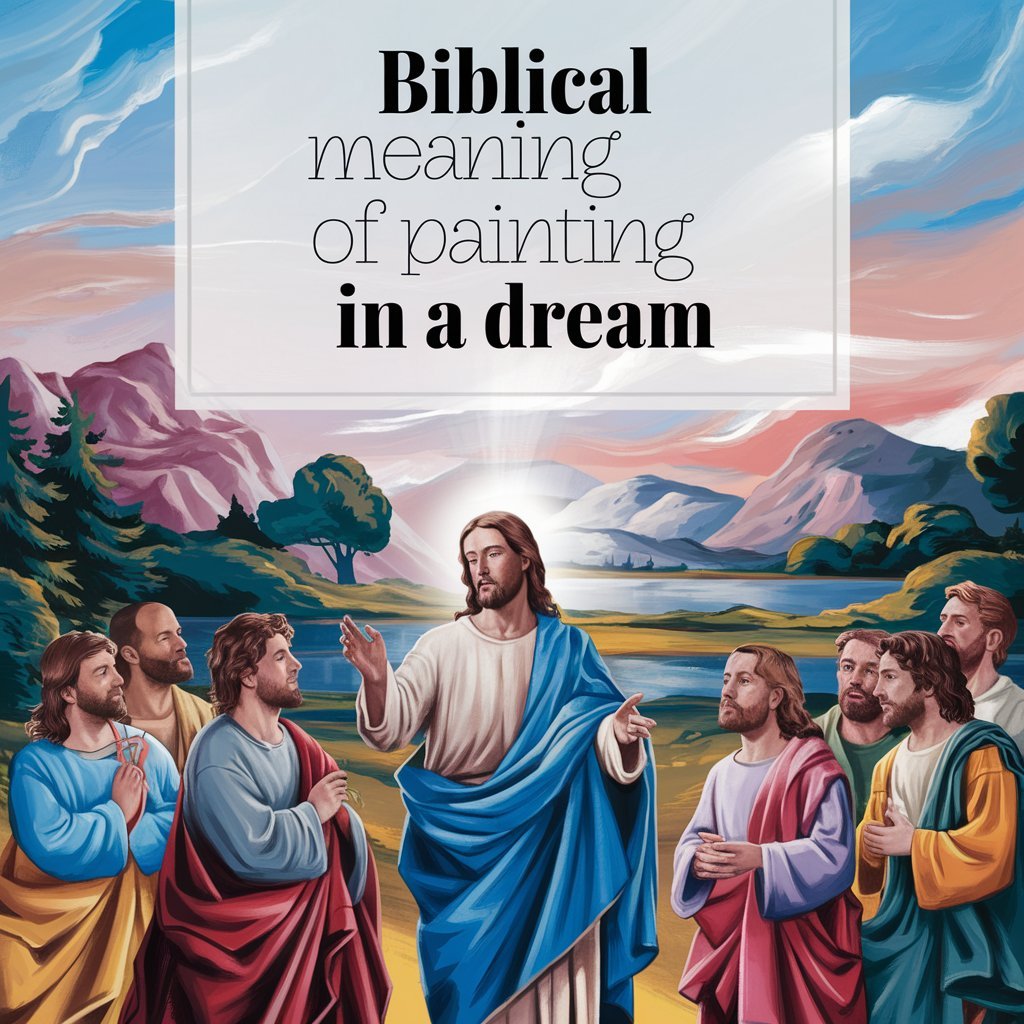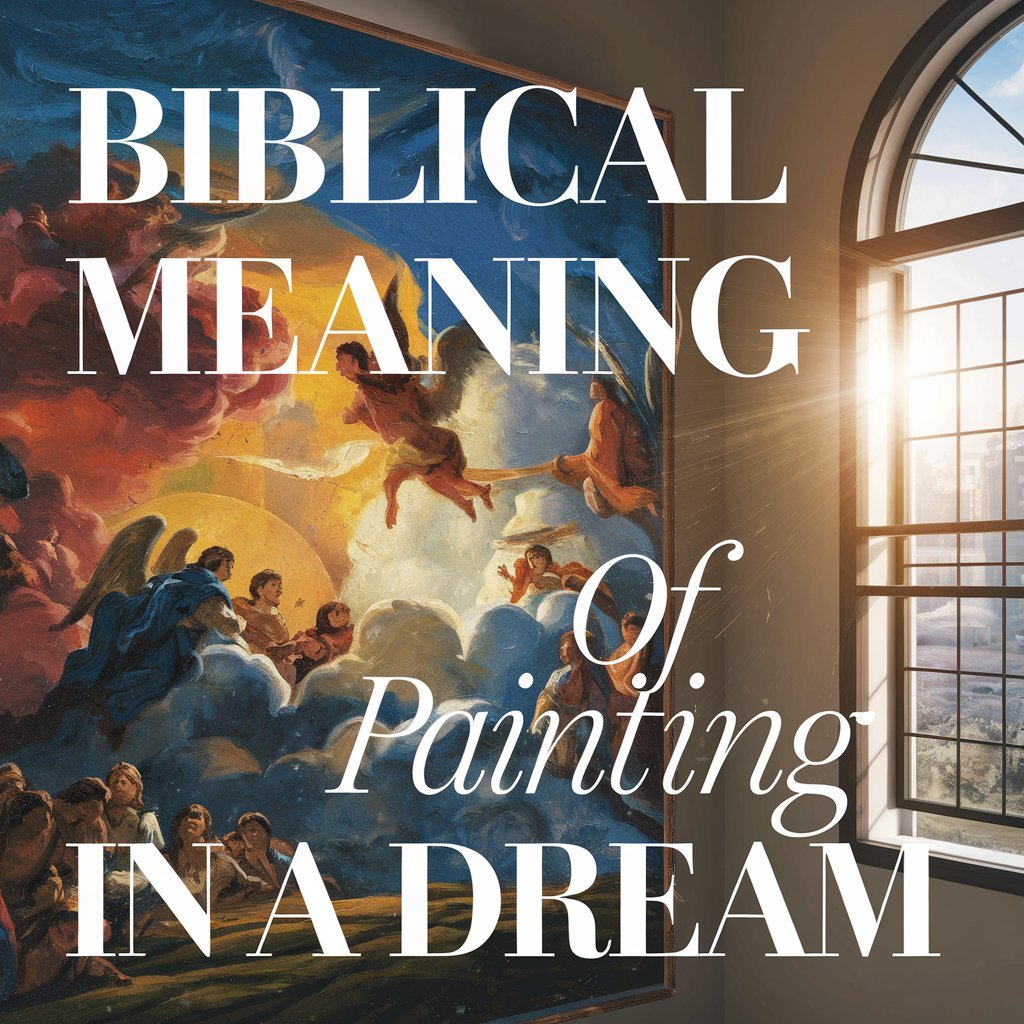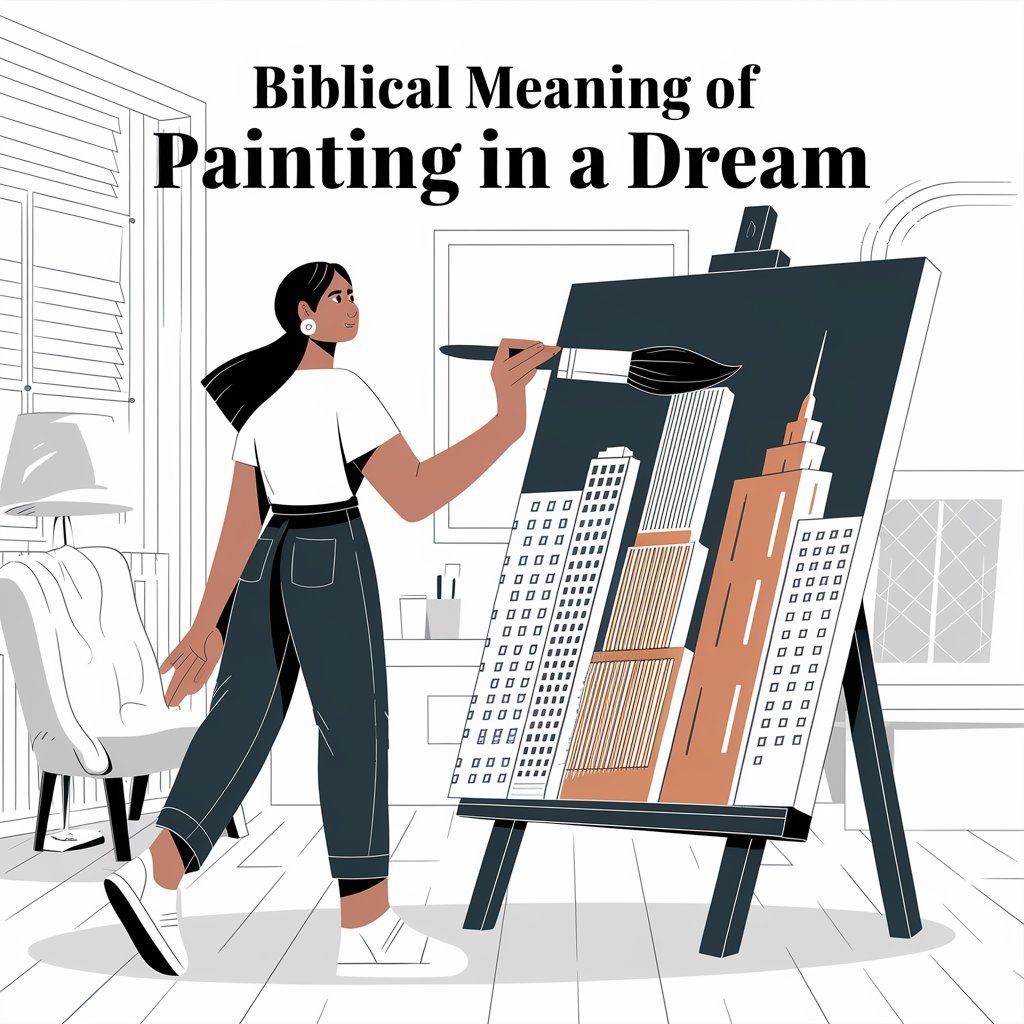15 Biblical Meanings of Painting in a Dream: Symbolism Revealed
As you reflect on your dream, where vivid colors and bold brushstrokes danced across the canvas, you can’t help but wonder what spiritual significance lies beneath. You’re not alone – in biblical symbolism, painting in a dream represents a sacred expression of faith, where every stroke and color choice conveys a deeper message.
But what does it mean when your subconscious takes up the brush? Are you being called to tap into your creative potential as a means of spiritual growth, or is there a hidden truth waiting to be uncovered? The answer, much like the canvas, remains blank – for now.
A Quick Overview

- In biblical contexts, painting or creating art in a dream can symbolize divine inspiration, wisdom, and spiritual growth.
- Colors used in the dream painting may hold symbolic meanings, such as blue for divine authority or red for life and redemption.
- The creative process in the dream can represent a spiritual journey, revealing hidden emotions, desires, and spiritual insights.
- The artwork itself may serve as a spiritual mirror, reflecting the dreamer’s innermost values, beliefs, and desires, and inviting introspection.
- The act of painting in a dream can signify surrender to divine guidance, allowing the dreamer to tap into their subconscious mind and connect with their faith.
Colors of Spiritual Significance
In the biblical narrative, you’ll discover that certain colors hold profound spiritual significance, conveying symbolic meanings that resonate throughout scripture.
These spiritual hues, imbued with divine intention, transcend mere aesthetics, speaking directly to the human heart.
You’ll find that colors like blue, often associated with divine authority and wisdom, are used to describe heavenly domains and sacred vessels.
Red, symbolizing life, sacrifice, and redemption, is linked to the blood of martyrs and the passion of Christ.
As you explore further, you’ll uncover the rich tapestry of color significance, woven throughout the biblical narrative.
Brushstrokes of Creative Expression

As you explore the symbolic meanings of colors, you’ll discover that the creative expression of biblical artists, from Bezalel’s intricate designs to the prophetic visions of Ezekiel, is infused with divine inspiration, manifesting in deliberate brushstrokes that convey spiritual truths.
These artistic expressions not only showcase technical skill but also reveal the artist’s inner world, shaped by their faith and spiritual experiences.
In this domain of creative freedom, art therapy can be a powerful tool for spiritual growth and self-discovery.
By embracing your own creative expression, you can:
- Tap into your subconscious mind and uncover hidden emotions
- Develop a deeper understanding of biblical narratives and their symbolism
- Cultivate a sense of spiritual connection and inner peace
- Express your faith in a unique and personal way
Canvas of the Subconscious
Your brushstrokes on the canvas can unseal the gates of your subconscious mind, revealing hidden fears, desires, and spiritual insights that lie beneath the surface of your conscious awareness.
As you create, you’re not just expressing yourself, but also tapping into the subconscious landscapes that shape your thoughts, emotions, and behaviors.
The colors, shapes, and textures you use are like mental murals, reflecting the inner workings of your mind.
By exploring these subconscious territories, you can gain a deeper understanding of yourself and your place in the world.
Your art becomes a window into your psyche, offering a glimpse of the complex, multifaceted self that lies beneath.
The Artist’s Spiritual Journey

Through the creative process, you set out on a profound spiritual journey, where the boundaries between artist, art, and the divine begin to blur, and the brushstrokes of your soul’s deepest longings and aspirations start to take shape.
As you plunge deeper into your craft, you begin to tap into a Creative Fervor that transcends the mundane, allowing you to access Divine Insight. This sacred connection fuels your artistic expression, imbuing it with a sense of purpose and meaning.
You start to see your art as a form of worship, a way to honor the divine within and around you.
Your creative process becomes a form of meditation, quieting the mind and tuning into the whispers of your soul.
You begin to recognize the interconnectedness of all things, and your art becomes a reflection of this unity.
Your art takes on a life of its own, speaking to the hearts of others and inspiring a sense of belonging and connection.
Hiding Behind a Mask
Behind the veil of artistic expression, you conceal a complex web of insecurities, fears, and doubts that threaten to undermine your creative authority.
You mask your true self, fearing judgment and rejection from others.
Social pressure to conform to certain standards or styles can lead you to hide behind a persona, rather than embracing your authentic personal identity.
This veil of pretence may bring temporary comfort, but it ultimately stifles your artistic growth and prevents you from tapping into your full potential.
Revealing Hidden Truths
As you peel away the layers of pretence, you’ll discover that your art reveals hidden truths about yourself, exposing the underlying emotions, desires, and motivations that shape your creative vision.
This inner reflection allows you to tap into your subconscious mind, uncovering hidden symbolism that might’ve gone unnoticed.
Through your art, you’re able to:
Unravel the complexities of your emotions
Identify patterns and habits that influence your behavior
Tap into your deepest desires and fears
Gain a deeper understanding of your values and beliefs
Uncovering Imperfections
Your paintings serve as a mirror, reflecting the imperfections that make you uniquely human, and by embracing these flaws, you’re able to confront the parts of yourself you’ve long tried to conceal.
This self-reflection allows you to acknowledge your human frailty, recognizing that it’s in these imperfections that you find true beauty.
Your brushstrokes, though imperfect, create a flawed masterpiece that tells a story of vulnerability and authenticity.
As you gaze upon your artwork, you’re reminded that it’s okay to not be perfect, that it’s in these imperfections that you find a sense of belonging.
Painting Over the Past
You actively choose to cover up the memories that haunt you, layering paint over the painful experiences that have shaped your life, thereby recontextualizing the narrative of your past. This process of painting over the past symbolizes your desire for personal growth and emotional release. By doing so, you’re not erasing the past, but rather, you’re reframing it to focus on the lessons learned and the strength gained.
It’s a form of self-compassion, allowing yourself to let go of the emotional baggage.
It’s an act of self-forgiveness, releasing the guilt and shame that have held you back.
It’s a declaration of independence from the past, claiming your freedom to move forward.
It’s a tribute to your resilience, proving that you can overcome even the darkest of experiences.
A New Canvas of Life
With every stroke of the brush, a new narrative unfolds, symbolizing your transformation into a blank canvas of life, where vibrant colors of hope and promise replace the once-dominant hues of pain and sorrow.
You’re not just painting a picture; you’re rewriting the script of your life. Each stroke represents a fresh start, a new chapter in your life’s journey.
As you fill the canvas with colors, you’re filling the pages of your life with purpose and meaning. You’re closing old chapters and opening new ones, leaving the past behind and embracing the future with anticipation.
With every brushstroke, you’re taking control of your narrative, and your life becomes a masterpiece of redemption and triumph.
The Color of Forgiveness
Forgiveness seeps into the canvas as a soothing balm, calming the turbulent waters of past hurts and resentments, as the gentle strokes of turquoise and lavender blend together in harmonious union.
As you paint, you realize that forgiveness isn’t just a feeling, but a choice – a deliberate act of letting go.
The Divine Palette guides your brushstrokes, whispering secrets of Color Harmony that resonate deep within your soul.
Turquoise represents clarity of thought and emotional balance.
Lavender symbolizes calmness, serenity, and peace.
The blend of these colors creates a soothing atmosphere, conducive to forgiveness.
This harmonious union on your canvas reflects the harmony you seek within yourself.
Art of Spiritual Renewal
As the soothing colors of forgiveness settle on your canvas, the palette of spiritual renewal begins to unfold, revealing the vibrant hues of transformation and rebirth.
You’re not just creating art; you’re crafting Sacred Vessels that hold the essence of your spirit.
Every brushstroke is a deliberate act of surrender, allowing the Divine Icons of your soul to emerge.
The colors blend and merge, symbolizing the fusion of your human and divine selves.
In this sacred process, you’re reborn, renewed, and rejuvenated.
Your art becomes a legacy to the transformative power of spiritual renewal, a reminder that you’re a masterpiece in the making, being shaped by the divine hand of the Creator.
Expressing Emotions Through Art
Through the dynamic interplay of color, texture, and form, your artistic expressions tap into the depths of your emotional landscape, giving tangible voice to the whispers of your soul.
As you create, you’re not just producing art, you’re processing emotions, and this emotional release is a fundamental aspect of art therapy.
By engaging with art, you’re cultivating emotional intelligence, which enables you to better understand and navigate your feelings.
This self-awareness is essential for emotional healing and growth.
You’re acknowledging and validating your emotions.
You’re developing a healthier emotional response to challenging situations.
You’re fostering a deeper connection with your inner self.
You’re accessing a powerful tool for emotional expression and release.
Spiritual Lessons From Art
Your artistic creations serve as a spiritual mirror, reflecting your innermost values, beliefs, and desires, and inviting you to confront the disparities between your creative expression and your lived faith.
As you engage in Art Therapy, you’ll uncover hidden patterns and gain insight into your spiritual journey.
This introspection allows you to refine your artistic voice, aligning it with your core values and faith.
You may discover that your creations are a manifestation of Divine Inspiration, guiding you towards a deeper understanding of yourself and your relationship with the divine.
Painting With Faith
When you approach painting with faith, you intentionally merge your creative process with spiritual principles, yielding a distinctive artistic language that not only reflects your beliefs but also fosters a deeper connection with the divine.
This fusion of art and spirituality gives birth to Faithful Creations that transcend mere aesthetics, speaking directly to the soul.
As you paint with faith, you:
Allow your Spiritual Vision to guide your brushstrokes, infusing your art with sacred meaning.
Trust in the divine plan, surrendering your creative control to a higher power.
Cultivate a sense of reverence and humility, recognizing the sacred in the mundane.
Create art that inspires, uplifts, and connects others to their own spirituality, fostering a sense of community and belonging.
Unraveling the Symbolic Message
As you infuse your art with spiritual meaning, you’re likely to incorporate symbolic elements that convey a deeper message, and now it’s time to decipher the code, uncovering the hidden layers of significance within your Faithful Creations.
To unravel the symbolic message in your dream, examine the artistic language you’ve employed. Consider the colors, shapes, and textures you’ve used, as these elements hold dream symbolism that can reveal the underlying themes and emotions in your subconscious.
Frequently Asked Questions
What Does It Mean to Dream of Painting a Portrait of Myself?
When you dream of painting a portrait of yourself, you’re engaging in self-reflection, acknowledging your inner beauty and uniqueness. This dream suggests you’re ready to explore and celebrate your authentic self, embracing your true essence and individuality.
Can I Control the Outcome of My Dreams About Painting?
You can influence the outcome of your painting dreams by practicing dream journaling, which allows you to tap into your subconscious reflection, gaining insight into your thoughts and emotions, and potentially shaping the narrative of your dreams.
Why Do I Always Dream of Painting With Watercolors?
You consistently dream of painting with watercolors because your subconscious is urging you to explore creative expression through a more fluid, adaptable medium, conveying subtle subconscious messages about embracing flexibility in your waking life.
Is It Significant to Dream of Painting Over a Finished Artwork?
You’re revisiting a finished piece, symbolizing a desire for creative correction. By dreaming of painting over it, you’re processing the need for artistic revision, indicating self-reflection and a willingness to refine your thoughts, emotions, and experiences.
Can I Learn to Interpret My Own Painting Dreams Accurately?
You can develop your skills in interpreting painting dreams by maintaining a dream journal to track recurring symbols and themes, then engage in symbolic exploration to uncover their personal significance, leading to greater self-awareness.
Conclusion
As you awaken from your dream, remember that painting symbolizes the harmonious union of your human and divine selves.
Your subconscious has conveyed a profound message, urging you to express your faith creatively.
Heed this call to artistic expression, and allow the colors and brushstrokes to guide you on a journey of spiritual growth, self-discovery, and connection with the divine.
By unraveling the symbolic meaning, you’ll reveal a deeper understanding of yourself and your relationship with the sacred.

Naomi White is an esteemed expert in spirituality with a passion for uncovering the hidden meanings and messages within divine symbols. Naomi’s work aims to bridge the gap between the mystical and the everyday, helping others find guidance and inspiration in the symbols that surround us all.







